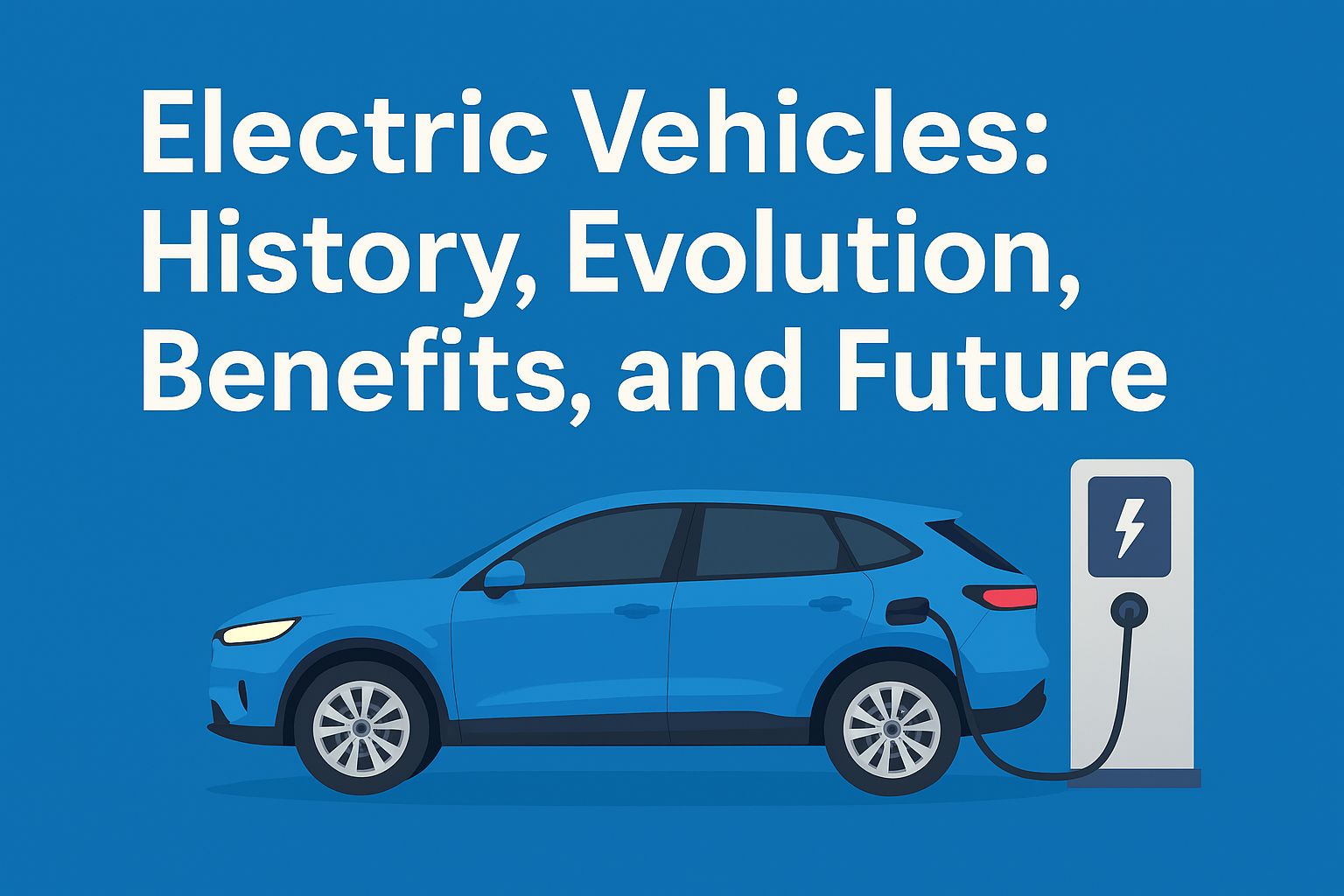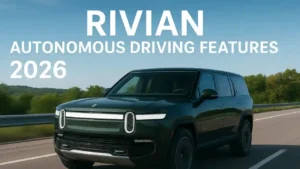Nowadays, the sales of electric vehicles (EVs) have increased significantly. In India, e-rickshaws are dominating local transportation, and electric buses are also performing well in many cities. In the car segment, models like the Tata Nexon EV and Tigor EV have shown remarkable growth in recent years. The two-wheeler market is also booming, with companies like Ola and Ather making strong progress.
But have you ever wondered how old this technology really is?
- When was the first electric vehicle invented?
- How has it evolved over time?
- Is it truly eco-friendly?
- What are the dark sides of EVs?
- And most importantly, what does the future of EVs look like?
Why the World Needed EVs
One of the main reasons behind the rise of electric vehicles is concern for the environment.
EVs influence the environment in several ways, and one of the biggest areas of impact is air pollution.
Traditional internal combustion (IC) engine vehicles release harmful tailpipe emissions, including CO₂, nitrogen oxides (NOx), and particulate matter. These pollutants contribute to air pollution, smog, and climate change.
In contrast, electric vehicles produce zero tailpipe emissions, making them a much cleaner alternative on the roads. Even when considering the overall carbon footprint, EVs generally have a smaller environmental impact compared to conventional vehicles.
The second major reason for the rise of electric vehicles is the limited availability of oil reserves.
We all know that petroleum resources are finite and will eventually run out. As global demand for fuel continues to grow, relying solely on these reserves is neither sustainable nor affordable in the long run.
Recognizing this challenge, researchers and industries began looking for alternatives. Electric vehicles emerged as one of the most practical and wise solutions—a cleaner and more sustainable option to reduce dependence on fossil fuels.
Benefits of Electric Vehicles
From some aspects, EVs are performing really well. One clear example is efficiency.
Traditional internal combustion (IC) engines are not very efficient—on average, they convert only 30–40% of the fuel’s energy into motion, while the rest is lost as heat and friction.
In contrast, electric vehicles are far more efficient, converting around 70–80% of electrical energy into actual motion. This means EVs make much better use of the energy they consume, giving them a significant advantage over conventional vehicles..
Another important advantage of electric vehicles is their contribution to quieter and more peaceful urban areas.
Diesel and petrol engines are often noisy, especially in crowded cities, adding to the problem of noise pollution. In contrast, EVs operate much more quietly, creating calmer roads and neighborhoods.
This reduction in noise not only improves the quality of life in cities but also supports the vision of building more peaceful and livable urban spaces.
A Brief History of Electric Vehicles
The history of electric vehicles (EVs) is more fascinating than many people realize. Let’s take a journey from the very beginning:
- 1828 – Hungarian engineer Ányos Jedlik created a small-scale model powered by a simple electric motor.
- 1834–1835 – American inventor Thomas Davenport built a small locomotive-like electric vehicle.
- 1837–1841 – In Scotland, Robert Davidson constructed the first practical electric carriage.
- 1879 – The first electric tricycle was demonstrated in Paris.
- 1889–1891 – American chemist William Morrison developed a six-passenger electric wagon, often considered the first successful EV in the United States.
- Early 1900s – EVs were highly popular; in fact, about 38% of all U.S. cars were electric, before gasoline cars took over.
Generations of Electric Vehicles
The development of EVs can be divided into different generations, each shaped by technology, economy, and global needs:
- First Generation (1800s–early 1900s):
Early EVs were slow, had limited range, and were mostly experimental. Despite their simplicity, they attracted interest before gasoline cars took over. - Second Generation (1970s–1990s):
Renewed focus on EVs came during the oil crises. However, progress was limited by poor battery technology, resulting in short ranges and high costs. - Third Generation (2000s):
The introduction of lithium-ion batteries revolutionized the EV industry by improving range and reducing costs. Iconic models like the Tesla Roadster, Nissan Leaf, and Chevy Volt emerged. - Current Generation (2015–2025):
EVs have now become more affordable, practical, and high-performance. Fast-charging networks, ranges above 500 km, and even AI-powered smart features are redefining modern mobility.
Key Benefits of Electric Vehicles
Electric vehicles are not just a trend—they bring real advantages for people and the planet. Here are the major benefits:
- Eco-Friendly:
Zero tailpipe emissions help reduce air pollution, smog, and greenhouse gases. - Energy Efficiency:
EVs convert about 70–80% of energy into motion, compared to only 30–40% in IC engines. - Lower Running Costs:
Electricity is cheaper than petrol or diesel, and EVs require less maintenance (no oil changes, fewer moving parts). - Reduced Noise Pollution:
EVs are much quieter than traditional vehicles, making cities more peaceful. - Reduced Oil Dependence:
With limited petroleum reserves, EVs reduce reliance on fossil fuels. - Performance & Innovation:
Instant torque, smoother drives, AI integration, and advanced tech features make EVs exciting to drive.
The Dark Sides of Electric Vehicles
While EVs offer many benefits, every technology has two sides. It’s important to also look at the challenges that come with electric vehicles:
- Battery Mining:
The extraction of lithium, cobalt, and nickel often causes environmental damage. In some regions, mining is also linked to unsafe labor practices, including child labor. - Battery Recycling:
Large-scale recycling systems for EV batteries are not yet widely available, raising concerns about future waste and disposal challenges. - Electricity Source:
EVs are only as clean as the electricity grid that powers them. If the energy comes primarily from coal, the environmental benefits are reduced. - High Initial Cost:
Although prices are gradually dropping, EVs still have a higher upfront cost compared to conventional vehicles. - Range Anxiety:
Many drivers worry about running out of charge during longer trips, even though charging networks are steadily improving. - Charging Time:
Even with fast chargers, recharging an EV takes more time than filling a petrol or diesel tank.
The Future of Electric Vehicles
The future of EVs looks promising, with innovations that will make them cleaner, faster, and more accessible. Some key trends include:
- Solid-State Batteries:
Next-generation batteries will be safer, offer higher energy density, and enable much faster charging compared to today’s lithium-ion batteries. - Wireless Charging Roads:
Dynamic charging technology may soon allow EVs to recharge while driving, eliminating the fear of running out of charge. - Integration with Renewable Energy:
EVs can act as mobile energy storage through Vehicle-to-Grid (V2G) technology, helping stabilize grids powered by solar and wind. - Autonomous EVs:
The combination of self-driving technology with electric mobility could redefine transport, making it safer and more efficient. - Cheaper Models:
As production scales up and technology improves, EVs will become more affordable—eventually cheaper than petrol and diesel cars. - Ban on Petrol Cars:
Many countries—including the UK, EU nations, Norway, and even India (by 2035–2040)—plan to phase out internal combustion engine (ICE) cars completely.
FAQs on Electric Vehicles
Q1: When was the first electric vehicle invented?
The first small-scale electric motor vehicle was built in 1828 by Ányos Jedlik, and by the late 1800s, practical electric carriages were already in use.
Q2: Are EVs completely eco-friendly?
Not entirely. While EVs produce zero tailpipe emissions, their overall eco-friendliness depends on how the electricity is generated and how batteries are mined and recycled.
Q3: Do EVs cost more than petrol cars?
Currently, EVs have a higher upfront cost, but they are cheaper to run and maintain in the long term. Prices are expected to drop further with mass adoption.
Q4: What is the main disadvantage of EVs?
The biggest challenges are battery mining, recycling issues, higher initial costs, and charging time compared to conventional vehicles.
Q5: How far can EVs travel on a single charge?
Modern EVs can travel over 500 km on a single charge, and with technology advancing, ranges are expected to increase further.
Q6: What does the future of EVs look like?
The future includes solid-state batteries, wireless charging roads, AI-powered features, cheaper models, and a global phase-out of petrol cars by 2035–2040.






